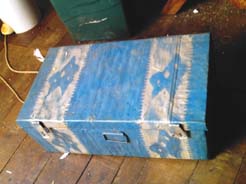
| Greetings Home |
| Previous Greeting |
|
|
Crtd 06-10-20 Lastedit 15-09-14
Fighting Shit
Some improvements of the dhow
Of course, time to relax should have come long ago, but I have to admit that some inconveniences, denoted by such unfortunate terms in this pages main header, thus far blocked the full breakthrough of uninhibited happiness.
Bloody Leaks: Main Deck Tent
We made a web page called "Closing the Deck" last May. A closed it was. We had several extreme rainstorms on our deck that did not succeed to get a drip inside. But after a week we would have some leaks again. We kept filling them with acrylic two component paint, hoping it would glue to all sides. But the fight seemed never ending. The reasons were hypothetical and diverse: may be lack of deck stiffness, partly wrong application of tape under the Sikaflex rubber kit, deck planks too wide, wrong type of wood for dry/wet application with sunlight and tropical rainstorms, finally: 100% closing of a wooden deck in these tropical conditions of heat/cold, wet/dry might be not doable anyway. Leaks somehow choose to appear right above books, electrical equipment and open store boxes ready to be turned into pools. So, we threw in the sponge, that is, we bought a great number of big standard metal boxes as used by boarding school children.

Photo: Standard Ugandan Boarding School Student's Box (metal, 5 euro)
And we ordered for the main (front) deck an expensive covering tent made of heaviest of truck tarpaulins.
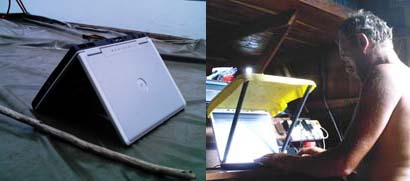
Photo: Left: laptop drying on deck after rainstorm.
Right: laptop roof made of cut out jerry can side and electricity tubes
Steering Deck: Sun Tent Collapse, Wooden Steering Deck Roof
Consistent "greetings" readers will remember that our steering deck sun tent blew off our deck one time, and generally was no match in strength to the folmali coming down, especially in windy situations. It was already damaged badly and it was only waiting for its definitive collapse. On the other hand the steering deck tent turned out not to need removal for sailing. So we learned that something permanent could be constructed, and we did.
Photo: Our new army green main deck tarpaulin and new steering deck roof with more than double solar capacity on top
Warm Beer: Solar Panel And Battery Capacity Increased
The steering deck roof could now nicely host our solar panels (always sun, and out of the way too). But they proved insufficient to power even our new low energy fridge. WARM BEER! So, we added panels to arrive at 440 W. That number is what we call Stickerwatt (the Watts you read on the sticker of the panel). On our boat at the Source of the Nile conditions that amounts to a peak delivery of 240 (real) Watt at a cloudless noon, an average delivery of 120 Watt from 09:00 to 17:00 hrs, that is, averaging over all 24 hours of the day, including the ones without significant sunforce: 40 W. But good enough to run a low energy 230 V fridge of 76 Stickerwatt (but somehow the Stickerwatts of power using equipment are always lower than the real Watts, while those of power producing equipment are higher), a computer, charge all chargeable gadgets, run 12 V TL all evening and pump an average of 70 litre of water per day out of the hold - considered an excellently low amount by local dhow connoisseurs. Moreover we bought a 190 AH 12 V truck battery (quite a job to get it in de canoe and then on board) to store our daytime excess power for evening use. With fridge off during sleeping and an occasional generator run on a cloudy day, we live like we have a viable electricity network supplying us. Ugandans living on the land can not say that nowadays: due to the low lake water level officially everybody suffers power shedding on every one day, and power cuts on the every other.
Photo: On anchor, the steering deck roof serves as a support of the 25 m folmali (lateen gaff). Our 6 sun panels stay clear of the folmali by means of a thick Mvule unsustainable hardwood edge on the roof, 30 cm high. Left background our reconditioned canoe
Wet Feet : Canoe reconditioned
On the left background in the photo above you see our canoe (story of purchase). Just reconditioned. It is an old second hand Ugandan type frameless canoe: six longitudinal planks are joined by hammering thin metal strips over the joints with many little nails. Between the metal strips they put a rubber band to reduce leaking. The method is derived from ancient times when halfrounds of twigs were sewn over the inside of the joints, and the joint was filled by anything sticky to be found here in the bush, like, if you are lucky, yes: rubber. Needless to say, canoes leak, and leak fast. To westernize the analysis, we developed the concept of sinking time. The normal sinking time of a canoe of the professional fishing fleet here is one day. Canoes do not sink because it is normal practice to bale water out between every two throws of your fish net. Anyhow, some water inside keeps your caught fish fresh. When our canoe approached the local average sinking time of one day we decided to have it fully reconditioned by Ugandans in the Ugandan way (the alternative: burning it and build a frame canoe ourselves, was rejected). For 30 euros ex paint we are back on the astonishing sinking time of ten days or more (calculating from what, net of rain water, we now bale out daily). Moreover, our fishermen's friends spontaneously took the trouble to paint the canoe in what is a clear attempt to mimic our dhow's colours: grey boards, red bottom (see photo above).
In The Strict Sense: Muzungu Bathroom
 As for sanitary facilities, in dhow context, there is of course only one serious
solution, which is the traditional one, the thunderbox: baskets equipped with decent holes,
hanging on the stern
As for sanitary facilities, in dhow context, there is of course only one serious
solution, which is the traditional one, the thunderbox: baskets equipped with decent holes,
hanging on the stern
Photo: dhow equipped with two "thunderboxes"
But since we expect to host westerners not used to civilized dhow culture, as a depression palliative (see Depression Battle), to pass days without too much misery, I built a tremendous mzungu toilet. When I gave a party to celebrate the finishing of my dhow, the toilet was ready, lonely towering port side in the main cabin 1 metre above the floor.
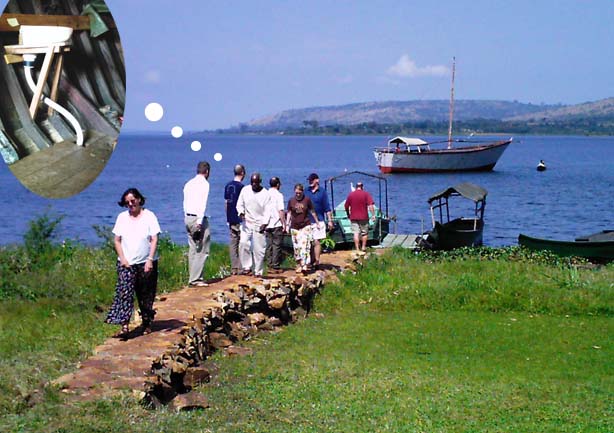
Photo: As it was, the toilet's user would be powerfully overlooking all events in de main cabin. Visitors of my Kingfisher Safari Lodge Lake Side party who went off shore to visit the dhow remember little but this magnificent piece of sanitary convenience and were quick to baptize it "The Throne". I am sure The Throne definitively established my reputation among the Jinja wazungu community.
Though bucket flushed, it had a real under-water outlet. Surrounded by a discreet curtain, it was all made from improvised parts: the pot is a squatting toilet, mounted in a rubber coated carefully shaped support, the outlet made of disparate connection hardware found in town shops. The mounting 1 m high, to get it out of the way, made necessary a foot support, removable by unscrewing bolts, because it rests on a piece of bottom floor wailing that has to stay removable, all this realized by building a handsome and firm wooden frame with sophisticated skewed joints. A major achievement. And it even worked!
However...
On launching The Throne, it turned out to insufficiently to trigger the mzungu feeling of hygiene comfort. The mzungu typically does not want to defecate on a Throne, not even behind a curtain. The mzungu wants a complete bathroom with hard walls behind which (s)he feels private, being liable to locking from the inside, thus at ease to cleanse the body from whatever is felt should be purged from it, that is, including inconveniences located at spots quite remote from the arsehole in the strict sense. This progress of our knowledge of the isolationist aspect of mzungu hygienic psychology - hygienic! if only they would have a similar politic! - inspired another week of hard work indeed.
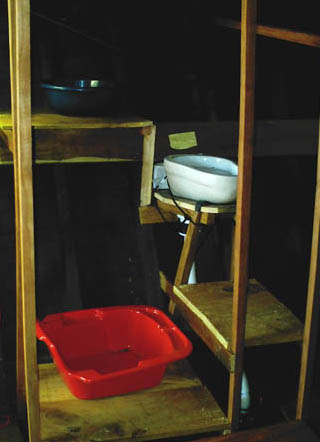
Photo: mzungu bathroom build up in progress. The idea is that the mzungu stands in the red tub (also usable as a baby bath). Your washing water is in the blue one. Waste water goes through the toilet.
Photo: Bathroom finished! Left: bathroom in "VACANT" state. Right: bathroom in "ENGAGED" state. This bathroom took us more time, thinking and effort then the entire rig (mast, gaff, sail and al ropes to operate it).
Not only did we manage to have the room electrically illuminated and equipped with a mosquito protected porthole overlooking Lake Vic, but to our own surprise we found a mzungu bathroom lock, made in China, for the affordable price of 6 euros, on the improbable venue of Jinja's old market. The bathroom lock is taken from the Caiga Xinrong Ornament Series, Made in Xinye, China EWS2000 Environment Protect Authentication, and its displays varied from "VACANT", if locked from the inside, to "ENGAGED" once unlocked. We were glad to forgive this the Chinese, cut from the plastic screw top of a 5 l mineral water bottle a perfectly blank white ring, covered the half formerly displaying "VACANT" with red tape, and thus arrived at genuinely, truthfully and in an the internationally recognized colour language white/red indicating the current states of our mzungu bathroom until deep in the unforeseeable future.
This is how far we, straight-lake-defecators and lake-dive-washers, went in order to become known as civilized hosts: hard walls surrounding a private room liable to inside locking with outside state display, lights, mirror, window, toilet and other advanced features for treating of a plethora of body parts before any morning greetings to fellow passengers. Right now, I am deeply engaged in writing the bathroom's Users Manual and Quick Start Guide.
I forgot, but let me add by way of Post Scriptum: we carefully jigsawed a plywood cover for the toilet and glued an airtight rubber band over the edges where it rests on the pot.
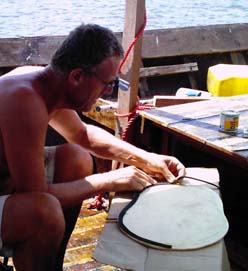
Photo: Airtight Rubber Applied On Toilet Cover
We managed to resist however, the obvious temptation to neatly mount it on the frame with hinges, but will do so at the first hint in such a direction that we will find in our suggestion box (all openings of which are locked, the key may be available, but only after considering a request specifying exactly what is planned to be suggested).
We finished off with pinned a detailed operating instruction:
| Operating Manual 1. Please throw any used
toilet paper OUT OF THE WINDOW. Troubleshooting guide The toilet is clogged.
A.
1. take the stiff rod of metal wire and carefully insert it in the exit hose B: Sneak unnoticed out of the the premises and deny everything
|
So far for shit.
Lake Flies: Increase of Net Wire Resolution
Our cabin doors have net wire as a cover (see here). Usually we have to be inside half an hour after sunset. At that moment the outside of the net wire will suddenly get covered almost completely with lake flies. They do not bite, but neither do they, if they are around you, allow you to continue life as usual. The lake fly party lasts an hour or two. Then, suddenly, they all disappear. There is one very tiny but numerous type of fly that manages to creep through our net wire, enters our cabin and sets out to darken our ceiling lights. Also, our hatches and windows have chinks serving as lake fly gateways (courtesy our fired carpenter Jonathan). Now our beer is cold, we do not want to see its attractive white head spotted, as if we ordered a cacao cappuccino, with dying flies. Moreover, our hatches leak. So we reconditioned our hatches, rubberized the joints with Sikaflex, made them shut neatly, and mounted a high resolution net wire. From 19:30 to 21:30: we in, flies out.
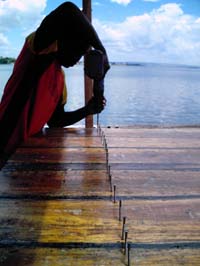
Photo: an African line of hatch frame screws (I am getting good at it: I drilled the holes personally)
Theft: New GPS
As reported, our spare GPS had been stolen in the Mwanza looting orgy. My father, visiting us, brought us a new Garmin outwitting my old navigation computer software with ease, so that I had to order an upgrade matching the GPS itself in prize.

Photo: My father inadvertently chose a GPS of a colour in the house style of our steering deck.
My six year old SUUNTO Vector watch reached Complete Irreparable Malfunction (CIM) a few months ago. I had decided not to buy a new one. In Africa, you do not need a watch, let alone a barometer and thermometer. And why have a compass if you even have a spare GPS receiver? Ridiculous! However, my father's unintended extension of our steering deck yellow-black house style made me change my decision.

Photo: My new SUUNTO Vector, featuring barometer, altimeter, thermometer and compass
Conclusion
Finished, so here comes trouble: we now seem to be entirely ready for doing nothing and yet be happy. (More about this problem: doing nothing).
| Greetings Home |
| Previous Greeting |
|
|